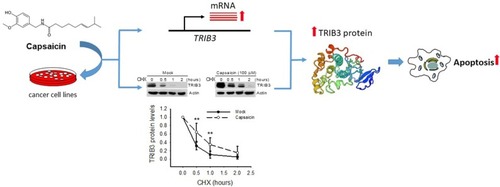Figures & data
Figure 1 Capsaicin induces the upregulation of TRIB3 in different cancer cell lines.
Notes: (A) Cancer cell lines vary in their TRIB3 expression levels. The protein (upper panel) and mRNA (lower panel) expression levels of TRIB3 were measured in seven different cancer cell lines. (B) AGS, MKN-45, and TMK-1 cells were seeded in a 96-well plate for 24 hours and then exposed to 0, 50, 100, 200 µM capsaicin for 48 hours. Cell viability was determined using the WST-1 reagent. n=5. *P<0.05 as the cell viability of MKN-45 was significantly different from those of AGS and TMK-1. (C) Cells were exposed to different concentrations of capsaicin and the protein levels of TRIB3 were determined. (D) MKN-45 and SiHa cells were treated with 100 µM capsaicin for 6–24 hours and the protein levels of TRIB3 were determined. All data were obtained from at least two to four independent experiments.
Abbreviation: n.s., not significant.
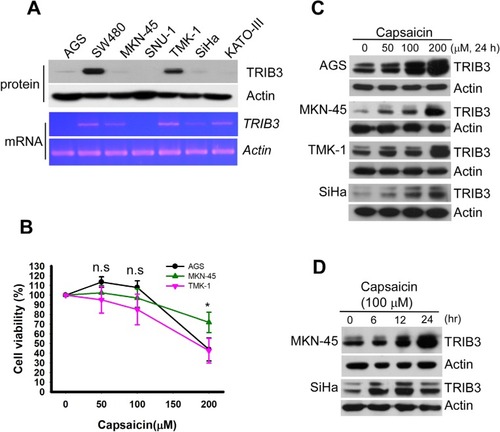
Figure 2 Capsaicin-induced upregulation of TRIB3 is accompanied by apoptosis.
Notes: (A–D) Cells were exposed to different concentrations of capsaicin and the specific protein levels were determined. All data were obtained from at least two to four independent experiments.
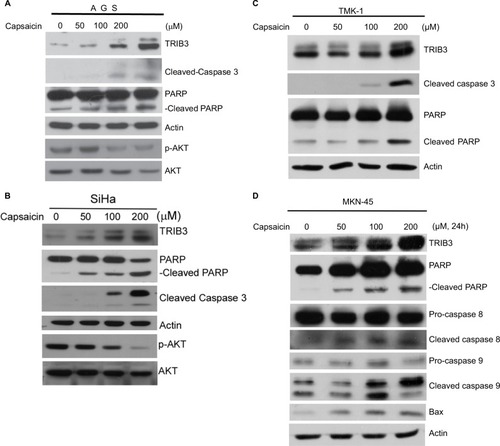
Figure 3 Induction of TRIB3 is essential for capsaicin-induced apoptosis.
Notes: (A) AGS cells were induced to express 2 µg ectopic TRIB3-Myc for 24 hours and exposed to 200 µM capsaicin for another 24 hours, and then the protein levels of TRIB3, TRIB3-Myc, cleaved caspase 3, and cleaved PARP were determined. (B) 2 µg TRIB3-Myc was expressed in AGS cells for 24 hours before exposure to 200 µM capsaicin for another 24 hours, and cell impedance was determined using an RTCA system. (C) AGS and TMK-1 were subjected to si-RNA–mediated knockdown of endogenous TRIB3 for 24 hours and then exposed to 200 µM capsaicin for another 24 hours. The protein levels of TRIB3, cleaved caspase 3, and cleaved PARP were determined. All data were obtained from at least three to five independent experiments.
Abbreviation: RTCA, real-time cell analysis.
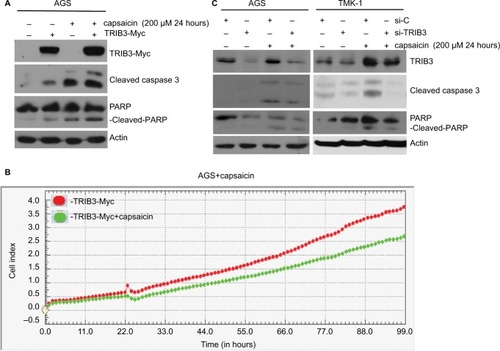
Figure 4 Capsaicin enhances TRIB3 mRNA expression and protein stability.
Notes: (A) AGS, MKN-45, and SiHa cells were treated with 10 µM MG132 for the indicated time periods, cell lysates were prepared, and the protein levels of TRIB3 were detected by immunoblotting. (B) Cells were treated with 50 µg/mL CHX for the indicated time periods, cell lysates were prepared, and the protein levels of TRIB3 were measured. (C) AGS cells were exposed to capsaicin for 24 hours, total mRNA was isolated, and real-time PCR was used to measure the mRNA expression of TRIB3. n=5. *P<0.05. The results of each experiment were normalized with respect to the expression of the internal control gene, TBP. (D) AGS and (E) MKN-45 cells were pretreated with or without capsaicin for 22 hours and then co-treated with 50 µg/mL CHX for 0–2 hours. The protein levels of TRIB3 were determined. All data were obtained from at least three to six independent experiments. n=3 for AGS, n=6 for MKN-45.
Abbreviations: CHX, cycloheximide; PCR, polymerase chain reaction; TBP, TATA- box binding protein.
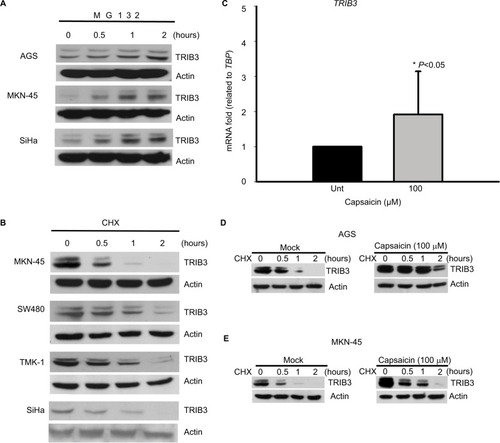
Figure 5 JNK and p38 MAPK signaling pathways do not appear to participate in the capsaicin-triggered upregulation of TRIB3.
Notes: (A) AGS cells were exposed to different doses of capsaicin for 24 hours, cell lysates were prepared, and the levels of various signaling proteins were determined. (B) AGS cells were pretreated with 10 µM SB203580 or SP600125 for 1 hour and then with 100 µM capsaicin for another 24 hours. The levels of TRIB3 were determined. (C, D) AGS cells were pretreated with 10 µM U0126 for 1 hour and then with 100 µM capsaicin for another 24 hours. The protein (C) and mRNA (D) levels of TRIB3 were determined. n=5. *P<0.05. The mRNA levels of TRIB3 were normalized with respect to the expression of the internal control gene, TBP.
Abbreviation: TBP, TATA-box binding protein.
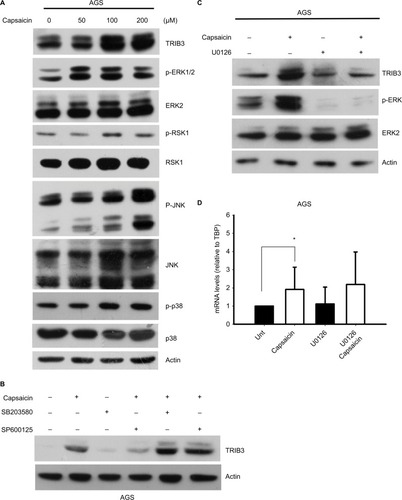
Figure 6 Capsaicin induced apoptosis through upregulating TRIB3 expression in cancer cells.
Notes: The proposed model is consistent with the published studies and the results described here. Capsaicin dose- and time-dependently induces TRIB3 expression via both stimulating gene transcription and stabilizing protein stability mechanisms to promote apoptosis in cancer cells.
Abbreviation: CHX, cycloheximide.
